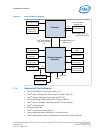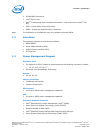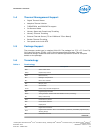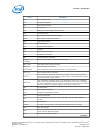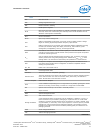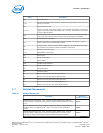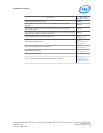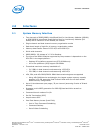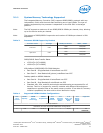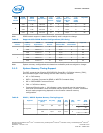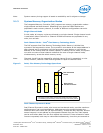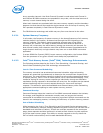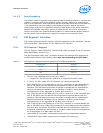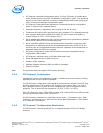
2.0 Interfaces
System Memory Interface
• Two channels of DDR3/DDR3L Unbuffered Dual In-Line Memory Modules (UDIMM)
or DDR3/DDR3L Unbuffered Small Outline Dual In-Line Memory Modules (SO-
DIMM) with a maximum of two DIMMs per channel.
• Single-channel and dual-channel memory organization modes
• Data burst length of eight for all memory organization modes
• Memory data transfer rates of 1333 MT/s and 1600 MT/s
• 64-bit wide channels
• DDR3/DDR3L I/O Voltage of 1.5 V for Desktop
• The type of the DIMM modules supported by the processor is dependent on the
PCH SKU in the target platform:
— Desktop PCH platforms support non-ECC UDIMMs only
— All In One platforms (AIO) support SO-DIMMs
• Theoretical maximum memory bandwidth of:
— 21.3 GB/s in dual-channel mode assuming 1333 MT/s
— 25.6 GB/s in dual-channel mode assuming 1600 MT/s
• 1Gb, 2Gb, and 4Gb DDR3/DDR3L DRAM device technologies are supported
— Using 4Gb DRAM device technologies, the largest system memory capacity
possible is 32 GB, assuming Dual Channel Mode with four x8 dual ranked
DIMM memory configuration
• Up to 64 simultaneous open pages, 32 per channel (assuming 8 ranks of 8 bank
devices)
• Processor on-die VREF generation for DDR DQ Read and Write as well as
CMD/ADD
• Command launch modes of 1n/2n
• On-Die Termination (ODT)
• Asynchronous ODT
• Intel Fast Memory Access (Intel FMA):
— Just-in-Time Command Scheduling
— Command Overlap
— Out-of-Order Scheduling
2.1
Processor—Interfaces
Desktop 4th Generation Intel
®
Core
™
Processor Family, Desktop Intel
®
Pentium
®
Processor Family, and Desktop Intel
®
Celeron
®
Processor Family
Datasheet – Volume 1 of 2 December 2013
18 Order No.: 328897-004




